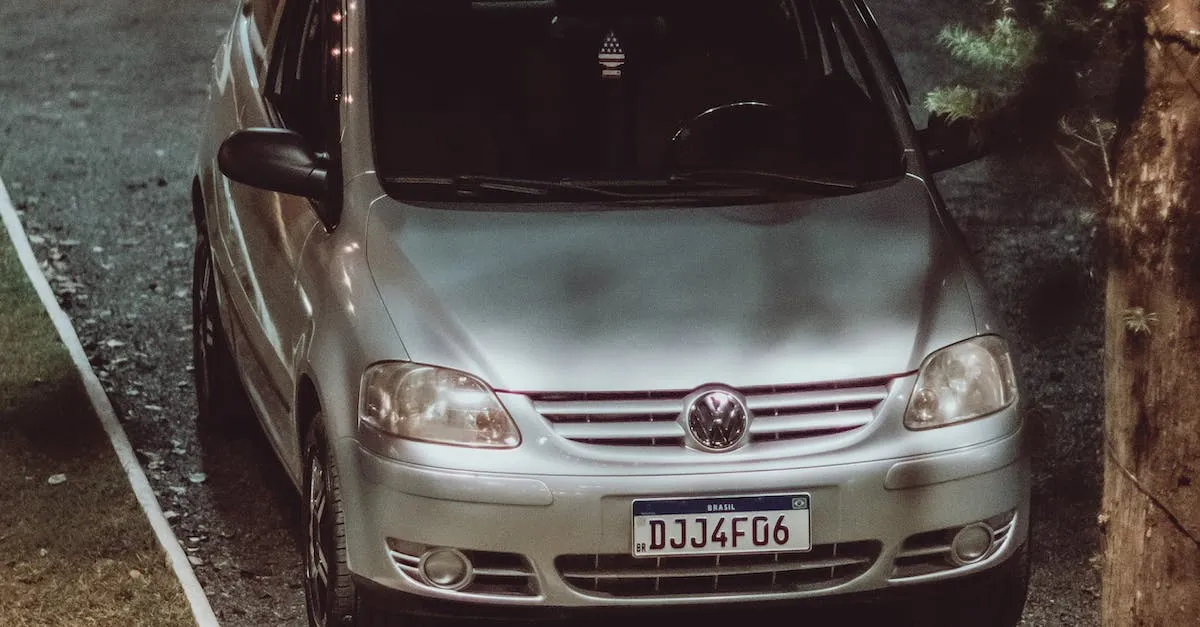Can You Get A Ticket For No Front License Plate In California?
Driving without a front license plate in California can be tempting for some vehicle owners who want a sleek, unobstructed front bumper. But is it legal to cruise around the Golden State without displaying a license plate on both the front and back of your car?
If you’re short on time, here’s a quick answer to your question: Yes, you can get a ticket for not having a front license plate in California. All vehicles registered in the state must display valid license plates on both the front and rear per California Vehicle Code Section 5200.
California’s Two-Plate Law
California’s Two-Plate Law refers to the requirement for vehicles registered in the state to display both a front and rear license plate. This law has been in effect for many years and is enforced by law enforcement agencies across the state.
Violating this law can result in penalties and fines for vehicle owners.
History and Purpose of the Law
The Two-Plate Law was implemented in California as a measure to enhance law enforcement and increase public safety. The main purpose of requiring two license plates is to make it easier for law enforcement officers to identify vehicles involved in criminal activities, hit-and-run incidents, and traffic violations.
Having two license plates, one on the front and one on the rear of the vehicle, allows for better identification and tracking of vehicles.
The law was also designed to ensure that vehicles are properly registered and licensed. The front license plate serves as a visible sign of registration, making it easier for authorities to verify the legality of a vehicle on the road.
Penalties for No Front Plate
If a vehicle in California does not have a front license plate displayed as required by law, the owner may be subject to penalties. These penalties can include fines, citations, and even potential vehicle impoundment.
The specific penalties may vary depending on the jurisdiction and the circumstances of the violation.
It’s important to note that there are certain exceptions and exemptions to the Two-Plate Law. For example, some vintage or collector vehicles may be eligible for a special license plate that only requires one plate to be displayed.
Additionally, motorcycles and certain types of commercial vehicles may also be exempt from the requirement to display a front license plate.
It is always recommended to comply with the Two-Plate Law in California to avoid any potential penalties or legal issues. Displaying both front and rear license plates not only helps law enforcement officers in their duties but also ensures that your vehicle is properly registered and licensed.
Exceptions to the Two-Plate Rule
Vehicles Registered in Other States
While California law requires vehicles to have both front and rear license plates, there are exceptions to this rule. One exception is for vehicles that are registered in other states. If you are driving a vehicle with out-of-state plates, you are not required to have a front license plate in California.
However, it is important to note that you must comply with the laws and regulations of the state in which the vehicle is registered. So, if your state requires a front license plate, you should have one installed.
According to the California Department of Motor Vehicles (DMV), “If you are moving to California or you are a new resident, you must register your vehicle(s) within 20 days of becoming a California resident.
When you register a vehicle in California, you must have evidence of financial responsibility and you must provide a California address.” You can find more information on the California DMV website here.
California Exempt and Special License Plates
Another exception to the two-plate rule in California is for vehicles with exempt or special license plates. These plates are issued to certain individuals or organizations that have specific privileges or exemptions.
Examples of exempt or special license plates include those issued to government agencies, law enforcement vehicles, and certain types of commercial vehicles.
If you have a vehicle with an exempt or special license plate, you are not required to have a front license plate. However, it is important to note that not all exempt or special plates qualify for this exception.
It is best to check with the California DMV or consult the California Vehicle Code to determine if your specific plate qualifies for the exemption.
The California DMV website provides more information on exempt and special license plates here.
Strategies to Avoid a No Front Plate Ticket
For drivers in California, having a front license plate is a legal requirement. However, there are strategies that can help you avoid getting a ticket for not having one. By being aware of your options and taking proactive measures, you can minimize the chances of facing a citation.
Here are some strategies to consider:
Temporary Front Plate Options
If you have recently purchased a new vehicle or are waiting for your front license plate to arrive, there are temporary options you can explore. One popular choice is using a temporary paper license plate.
These plates are usually provided by the dealership or the Department of Motor Vehicles (DMV) and must be displayed prominently on the front of your vehicle. It’s important to note that these temporary plates have an expiration date, so make sure to obtain your permanent plate before it expires to avoid any penalties.
Another temporary option is a license plate bracket that attaches to your vehicle’s front grille or bumper. These brackets allow you to display a temporary or personalized plate until your permanent plate arrives.
However, it’s essential to ensure that the bracket is securely attached and does not obstruct your vehicle’s visibility or violate any other regulations.
Contesting a Citation in Court
If you do receive a ticket for not having a front license plate, you have the option to contest it in court. This strategy requires you to present a valid argument and evidence that supports your case.
For example, you may argue that your vehicle was manufactured before the requirement for front license plates came into effect or that the officer made an error in issuing the citation. It’s important to consult the California Vehicle Code and seek legal advice to determine the best approach for your specific situation.
When contesting a citation, gather any relevant documentation, such as photographs, receipts, or repair records, that can support your claim. Prepare a strong argument and present it confidently in court. Remember to remain respectful and professional throughout the process.
Getting a Two-Plate Exemption
In some cases, you may be eligible for a two-plate exemption in California. Certain vehicles, such as motorcycles, vintage cars, and some trucks, are exempt from the front license plate requirement. However, it’s crucial to review the specific regulations outlined by the California DMV to determine if your vehicle qualifies for this exemption.
If you believe your vehicle meets the criteria for a two-plate exemption, you can apply for a special license plate exemption through the DMV. This process typically involves submitting an application and providing supporting documents, such as proof of ownership and vehicle specifics.
Keep in mind that these exemptions are granted on a case-by-case basis, so it’s important to thoroughly review the requirements and submit a complete application.
Remember, it’s always best to comply with the law and display a front license plate on your vehicle if required. However, if you find yourself without a front license plate, these strategies can help you navigate the situation and potentially avoid a ticket.
Stay informed, be proactive, and take the necessary steps to ensure you are in compliance with California’s regulations.
Regional Enforcement of the Front Plate Law
When it comes to enforcing the front license plate law in California, different regions have varying levels of strictness. Let’s take a closer look at how different parts of the state approach this issue.
Southern California
In Southern California, particularly in densely populated areas like Los Angeles, the enforcement of the front license plate law is taken quite seriously. Law enforcement officers in this region are known to actively enforce this requirement and issue tickets to vehicles without a front license plate.
If you’re driving in Southern California, it’s important to ensure that your vehicle has a front license plate properly displayed. Failure to do so could result in receiving a ticket and having to pay a fine.
It’s worth noting that the fine for not having a front license plate in California can range from $25 to $200, depending on the specific circumstances.
Bay Area and Northern California
In the Bay Area and other parts of Northern California, the enforcement of the front license plate law is generally less strict compared to Southern California. While it is still technically required to have a front license plate, law enforcement officers in this region may be less likely to issue tickets for this specific violation.
However, it’s important to remember that this can vary depending on the specific jurisdiction and the officer’s discretion. It’s always better to err on the side of caution and make sure your vehicle has a front license plate to avoid any potential issues.
Central Valley and Central Coast
In the Central Valley and Central Coast regions of California, the enforcement of the front license plate law tends to be more relaxed. Law enforcement officers in these areas may prioritize other traffic violations over the absence of a front license plate.
While this doesn’t mean you won’t receive a ticket for not having a front license plate in these regions, the likelihood may be lower compared to other areas of the state. However, it’s still important to comply with the law and display a front license plate on your vehicle.
The Future of Front Plates in California
One of the ongoing debates in California is whether or not drivers should be required to have a front license plate on their vehicles. Currently, the state laws mandate that all vehicles must display both a front and rear license plate.
However, there have been discussions and proposed legislation that could potentially change this requirement. Let’s take a closer look at the future of front plates in California.
Previous Legislative Attempts
Over the years, there have been several attempts to eliminate the requirement for front license plates in California. Proponents argue that removing the front plates would give vehicles a sleeker appearance and reduce the risk of damage caused by front-end collisions.
However, these efforts have not been successful so far, as law enforcement agencies and other organizations have expressed concerns about the potential negative impacts.
According to a study conducted by the California Highway Patrol (CHP), front license plates play a crucial role in law enforcement efforts. The front plates provide an additional means of identifying vehicles involved in criminal activities, hit-and-run incidents, and traffic violations.
Without front plates, it would be more challenging for law enforcement officers to accurately identify and apprehend offenders.
Law Enforcement Perspective
Law enforcement agencies in California strongly support the requirement for front license plates. They argue that front plates enhance public safety by aiding in the identification of vehicles involved in crimes or traffic violations.
Front plates also assist in the recovery of stolen vehicles and provide valuable evidence in investigations. The presence of a front plate can make a significant difference in solving crimes and bringing offenders to justice.
According to the California Police Chiefs Association (CPCA), eliminating the front plate requirement would hinder their ability to effectively enforce traffic laws and investigate crimes. They believe that the benefits of front plates outweigh any potential inconveniences for drivers.
Front Plate Requirements in Other States
While California requires front license plates, it’s worth noting that not all states have the same requirement. In fact, only 31 states currently mandate the use of front plates. Some states, like Texas and Florida, only require rear plates.
Other states, such as New York and Ohio, have chosen to keep the requirement for both front and rear plates. The decision to require front plates varies from state to state, and is often influenced by law enforcement considerations and other factors specific to each jurisdiction.
To learn more about front plate requirements in other states, you can visit the official website of the American Association of Motor Vehicle Administrators (AAMVA) at www.aamva.org/vehicle-attribute-data/.
Conclusion
In summary, California’s two-plate license law remains in effect statewide, meaning drivers are required to display front and rear plates on their vehicles. While enforcement levels vary regionally, all vehicle owners should be aware they can receive citations for missing front plates. To avoid tickets, use temporary or exempt plates when allowed, or ensure your vehicle has a front plate properly mounted. The future of California’s two-plate requirement remains uncertain, but changes seem unlikely in the near term.








